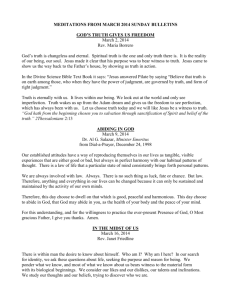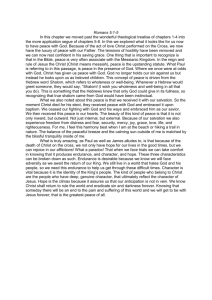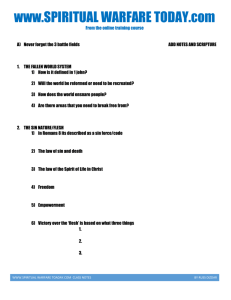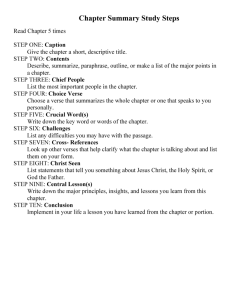File - Andrew Busch
advertisement
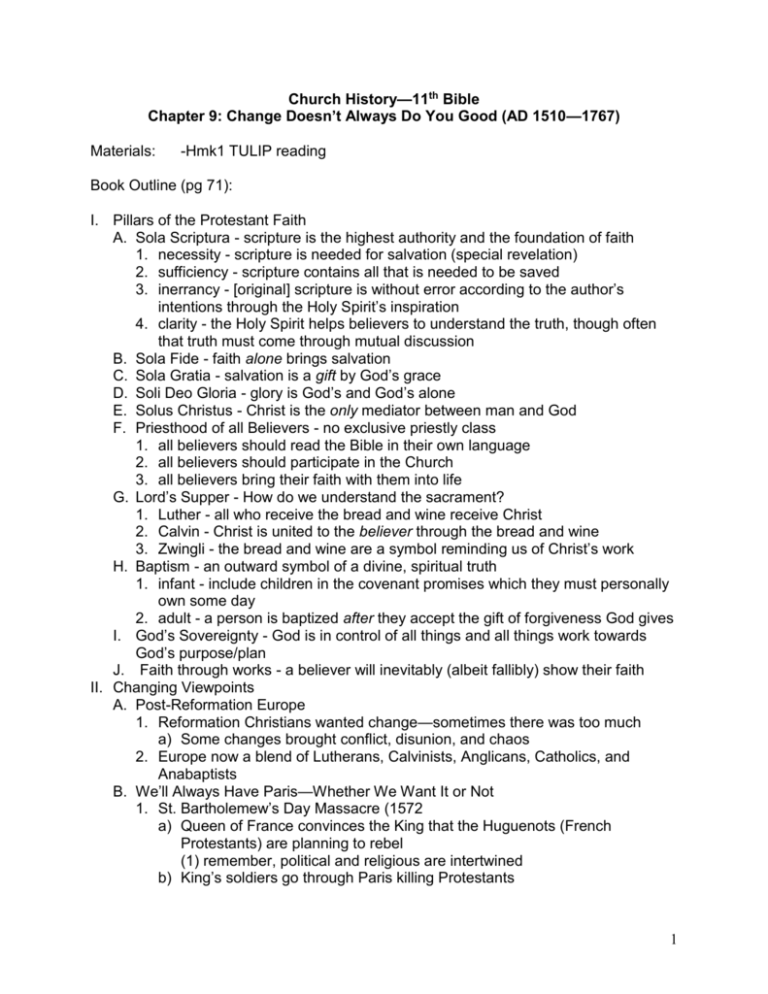
Church History—11th Bible Chapter 9: Change Doesn’t Always Do You Good (AD 1510—1767) Materials: -Hmk1 TULIP reading Book Outline (pg 71): I. Pillars of the Protestant Faith A. Sola Scriptura - scripture is the highest authority and the foundation of faith 1. necessity - scripture is needed for salvation (special revelation) 2. sufficiency - scripture contains all that is needed to be saved 3. inerrancy - [original] scripture is without error according to the author’s intentions through the Holy Spirit’s inspiration 4. clarity - the Holy Spirit helps believers to understand the truth, though often that truth must come through mutual discussion B. Sola Fide - faith alone brings salvation C. Sola Gratia - salvation is a gift by God’s grace D. Soli Deo Gloria - glory is God’s and God’s alone E. Solus Christus - Christ is the only mediator between man and God F. Priesthood of all Believers - no exclusive priestly class 1. all believers should read the Bible in their own language 2. all believers should participate in the Church 3. all believers bring their faith with them into life G. Lord’s Supper - How do we understand the sacrament? 1. Luther - all who receive the bread and wine receive Christ 2. Calvin - Christ is united to the believer through the bread and wine 3. Zwingli - the bread and wine are a symbol reminding us of Christ’s work H. Baptism - an outward symbol of a divine, spiritual truth 1. infant - include children in the covenant promises which they must personally own some day 2. adult - a person is baptized after they accept the gift of forgiveness God gives I. God’s Sovereignty - God is in control of all things and all things work towards God’s purpose/plan J. Faith through works - a believer will inevitably (albeit fallibly) show their faith II. Changing Viewpoints A. Post-Reformation Europe 1. Reformation Christians wanted change—sometimes there was too much a) Some changes brought conflict, disunion, and chaos 2. Europe now a blend of Lutherans, Calvinists, Anglicans, Catholics, and Anabaptists B. We’ll Always Have Paris—Whether We Want It or Not 1. St. Bartholemew’s Day Massacre (1572 a) Queen of France convinces the King that the Huguenots (French Protestants) are planning to rebel (1) remember, political and religious are intertwined b) King’s soldiers go through Paris killing Protestants 1 c) 10,000 die in one day 2. Edict of Nantes a) Protestantism doesn’t become legal in France until 1598 3. Internal strife among the Protestants as well a) Lutherans argue about Total Depravity b) Calvinists argue about Predestination C. Predestination—On What does It Depend? 1. Jacob Arminius (late 1500’s) a) Popular Dutch Calvinist pastor b) Agrees to defend Calvin’s views but after researching both sides, agrees with his opponent. (1) Splits the Calvinist movement c) Arminian Remonstrance (published the year after Arminius died: 1609) (1) Although human nature was seriously affected by the fall, people still have the ability to choose God with their free will. (2) Before the foundation of the world, God chose to save everyone who would freely choose to trust Christ. (3) Jesus died for everyone, but his death only redeems believers. (4) People can choose to reject God’s attempts to save them. (5) Scripture doesn’t clearly state whether Christians can forfeit their salvation. d) “These Articles set out what is…sufficient for salvation. It is unnecessary to look higher or lower” 2. Synod of Dordt (1618) a) In order to respond to each of the Arminians’ five statements b) Calvinist pastors come from around Europe and develop the five points of Calvinism (1) Human beings are by nature spiritually dead. No one naturally desires to seek Christ (Romans 3:10-12; Eph 2:1-3) (a) Total Depravity (2) If someone trusts Christ, it is because God chose to regenerate that person. God’s choice is unconditional; it isn’t based on any human decision (John 6:44; Romans 9:10-16) (a) Unconditional Election (3) Christ’s death atoned for only those who would believe in him (John 3:16) (a) Limited Atonement (4) When God regenerates someone, that person will neither resist nor reject God’s grace (John 6:37, 44) (a) Irresistible Grace (5) Every Christian will persevere in faith until the end (John 10:27-28; Romans 8:29-39) (a) Perseverance of the Saints c) “Predestination had been only one part of Calvin’s theology. Its purpose was to assure Christians of God’s love. After the Synod of Dordt, predestination became the center of Calvinist theology. Among some 2 Calvinists, strict confessions of faith displaced a dynamic faith-relationship with Christ.” (p95) 3. TULIP Reading and worksheet. 4. TULIP and Predestination (again) – The five points of Calvinism [This will most definitely be on the test.] a) Total Depravity b) Unconditional Election c) Limited Atonement d) Irresistible Grace e) Perseverance of the Saints f) According to Calvinism, who is responsible for salvation? g) What must happen first before a person may come into the knowledge of salvation? (1 Cor. 2:14) h) What does Unconditional Election not remove from man? (John 3:16-18) i) What are God’s children redeemed to do? (Rom. 7:4, 8:28-30; Eph. 1:1112, 2:10) j) How does Limited Atonement actually promote the spreading of the gospel? (Rom. 10:9-10, 14-15) k) How is the Trinity at work in Irresistible Grace? Father (John 6:44) - 3 Son (Heb. 10:10, 12) - Holy Spirit (Rom. 8:13-14) - l) How can Perseverance of the Saints act as a comfort to those who have accepted Jesus Christ? (Philippians 1:6) D. How Many Poles Does It Take to Change the World? 1. Nicolas Copernicus (mid 1500s) a) Re-popularized the idea that the sun was the center of the universe (1) Which was actually first suggested by the Greeks b) He delayed the release of his work but no one knows the exact reason. (1) Perhaps he was afraid of criticism from the scientific community (2) Perhaps he was afraid of what some in the church might think. (a) At this point the church was very enthusiastic about the idea c) Scholars from around Europe continually asked him to publish. 2. Galileo (late 1500’s to mid 1600s) a) By 1616 Copernicus’ ideas had come under attack from the church (1) Europe has fragmented under the Protestant Reformation and the Catholic Church is retrenching. (a) lashing out at new ideas (b) during the Renaissance it supported new scientific thought b) 1632, Galileo publishes work with permission from both the Pope and the Inquisition under the conditions (1) he explains argument both for and against heliocentrism (2) do not advocate for heliocentrism (3) write about the Pope’s own views (geocentrism) in the book c) Galileo uses a character he calls “Simplicio” to defend the Earth-centered model. (1) simplicio = simpleton (2) the character comes across as a fool (3) the character uses pieces of the Pope’s conversation with Galileo (4) The Pope is not a happy camper d) Galileo is called to Rome to defend his ideas. (1) Psalm 93:1, 96:10, 1 Chronicles 16:30, Psalm 104:5, Ecclesiastes 1:5 (2) The charge, asserting an idea opposed to what is clearly taught in Scripture (3) He renounces his writings (4) He is sentenced to house arrest for the rest of his life e) Something changes in the scientific community and they refuse to be silenced by the church. 4 III. Changing Countries A. Well, That’s One Way to End a Business Meeting (30 Years’ War) 1. Instigation a) Meeting in Prague between Bohemian Protestants and Catholic envoys of the King. b) The Catholic envoys refused to listen to the Protestants’ complaints c) The Protestants threw the envoys out a second story window. d) The King declares war on the Protestants (30 Years’ War) 2. The war itself a) At first it was about religious toleration b) Became political c) Included: The Holy Roman Empire, France, Denmark d) 10 million dead 3. Peace of Westphalia a) ends the conflict in 1648 b) the Pope doesn’t preside over the proceedings. B. Puritans—They Weren’t What You May Think 1. Wanted to reform, or ‘purify’, the church of England 2. The current historical perception of the Puritans is of boring people who didn’t want anyone else to have fun either. a) That’s not even close to being accurate. 3. Did not want any church practices not required by Scripture 4. King James Version of the Bible a) The Puritans preferred the Geneva Bible translation b) King James didn’t like the Calvinist study notes c) A new translation was suggested at the Hampton Court Conference (1604) d) King James readily agreed and financed the process e) 47 scholars worked for just under 3 years to create the translation f) 1611 the first KJV was printed. 5. Splitting the church of England a) After the Hampton Court conference some Puritans separated from the English Anglican church b) They fled to Holland in 1607 for safety. c) Some sailed west to the New World (1) Pilgrims (2) Settled on the coast of Massachusetts d) Still others stayed in Holland and founded the Baptist movement. C. The First English Baptists 1. John Smyth a) Leader of one of the Dutch Puritan congregations b) Embraced the idea of Believer’s baptism (1) Infant baptism is invalid (2) Everyone needs to be re-baptized c) Embraced Arminian theology (1) The general (universal) extent of Christ’s atonement 5 d) “Brothers of the Separation of the Second English Church in Amsterdam” (1) Known as ‘Baptists’ e) Thomas Helwys leads a congregation to found the England’s first Baptist church in London. D. John Bunyan Wasn’t a Lumberjack 1. Religious suppression a) King James’ son, Charles demands all churches become Anglican (1) The dispute immediately becomes political b) Oliver Cromwell (1) Member of Parliament (2) Forms a pro-Puritan party (a) basically English Calvinists (b) i.e. the Reformed church in England (3) Controls the country within 5 years (4) Executes King Charles and his archbishop 2. John Bunyan a) 1648, Marries and has almost no possessions except for a few Puritan books. b) Realized he had never really trusted Jesus as the Christ. c) 1653, Becomes a Baptist and a traveling preacher d) Practices religious tolerance to Christians of other denominations e) 1660, Cromwell’s Commonwealth ends and King Charles’s son suppresses all non-Anglican churches f) Bunyan arrested g) Writes Pilgrim’s Progress while in prison. (1) popular allegory on the life of faith 3. 1688, Toleration Act a) Allowed anyone who agreed to a list of 39 doctrines freedom of worship IV. Changing Cultures A. Columbus 1. 1492 Columbus comes to the Americas seeking another route to India 2. The textbook seems to think his trip was religiously minded. Most people think he was in it for wealth. B. The Trust-Jesus-Or-Else Campaign 1. Spain and Portugal send troops to subdue the New World 2. They claimed they were evangelizing not conquering 3. This was a religious veneer on a political scheme. a) Exterminating or enslaving the indigenous population in a land of enormous wealth (sugar, spices, gold) C. Slaves of Sugar 1. Technicalities a) Technically, it was illegal in Spain and Portugal to enslave a native b) To get around this, Spanish settlers had Native Americans ‘entrusted’ to them in order to teach them about Christ. (1) It was simply a show to get around the letter of the law (2) Native Americans were severely abused by the system 6 c) The populace in Europe generally did not know what was going on. (1) They thought their country was doing a good thing: bringing Jesus to the lost souls in the New World 2. Bartolome’s barren battle (Bartolome de Las Casas) a) Spanish priest in Haiti b) Owned a plantation in Haiti c) After 4 years, on Pentecost Sunday he freed all his natives, closed his plantation, and became the first powerful defender of natives’ rights. d) He returns to Spain and pleads their case. e) The Pope sides with Bartolome and passes a law limiting what Spain (a Catholic country) may do with natives. 3. A new source of slaves, a new curse on the Americas a) Do to Bartolome and disease, the Europeans needed to look for a new source of cheap labor. (1) The Aztecs were completely destroyed by small pox (2) The Mayan population was reduced from 18 million to 1 million b) They enslaved and imported Africans (1) Rationalized the decision at first by saying that all the slaves being sold were prisoners of war (people who had attacked other villages) (2) Soon there were too many to actually believe this and the Africans were dehumanized to allow for the institutionalized cruelty 4. The slave of the slaves (Pedro Claver) a) Jesuit Missionary in Columbia (1622) b) Convinced his monastery to buy Africans, so they could become brothers and teach him African languages. c) Met the Africans as they got off the slave ships and preached to them in their own languages. d) Pedro was despised because he called attention to the horror of the slave trade. e) Died naked and alone (1) His clothes and possessions were stolen because they would be worth money if he became a saint. f) Jesuit Missions (1) The Jesuits built settlements for the natives. The natives were treated as equals (2) 1628 Portuguese and Spanish plantation owners attached the Jesuit missions and enslaved their natives (see the movie “The Mission”) (3) The Jesuits continued to move further inland. The slave traders pursued them. (4) 1640, the Jesuits arm the missions and allow the natives to defend themselves. (5) By 1731, 150,000 Native Americans were living within Jesuit missions. (6) Slave owners began to hire armies to attack the missions and capture the inhabitants. (7) 1767, Spain forces the Jesuits to leave the New World. V. It Takes More than Change 7 A. Change isn’t always bad, but neither does it solve every problem B. Christians were still looking for earthly power and authority, confusing the Kingdom of God with the Kingdom of Men. 8 Protestant Theology All Protestants hold at least three things in common. What are they? 1. 2. 3. The Lord’s Supper Luther Zwingli Calvin (reformed) Luther Calvin John Smyth (Baptist) What they believed Why they believed it Baptism What they believed Why they believed it Church-State Relations 9 Luther Calvin Puritans What they believed Why they believed it The Way of Receiving Salvation Calvin What they believed Arminian 1. 1. 2. 2. 3. 3. 4. 4. 5. 5. Why they believed it 10 Go over Summary Page of AD 1510-1767 on page 92 with students. Student Questions: Chapter Nine: “Change Doesn’t Always Do You Good” 1. What is meant by the term post-Reformation? How can this period of history be described? 2. What happened on the evening of St. Bartholomew’s Day in Paris, France in 1572? What is significant about the Edict of Nantes dated 1598? 3. Within the Calvinist movement, Jacob Arminius disagreed with the doctrine of predestination. List below the five beliefs about salvation as published by Arminius, called the Remonstrance? 1. 2. 3. 4. 5. 4. What was the purpose of the Synod of Dordt in 1618? 5. List below the five points of Calvinism as drafted by the Synod of Dordt. 1. 2. 3. 4. 5. 6. At this time, predestination became the center of Calvinist theology. What occurred among some Calvinists because of this emphasis? 7. In the mid-1500’s, what theory did Copernicus hold, that he dared not reveal until he was on his death-bed? 8. What price did Galileo pay for carrying these ideas to the publisher? What was the church afraid of? 9. Who was significant in the “Thirty Years War”? How many perished in this war? What significant change do we see as a result of the Peace of Westphalia that ended the war? 10. In England, there was also religious struggle. What was the goal of the Puritans and what was their belief concerning the Bible? 11. What significant event occurred in 1611, as endorsed by King James I? 11 12. Various groups separated from the Anglican Church in England. One particular group was led by John Smyth. What belief did they hold concerning baptism and how did they view Christ’s atonement? What name did they become known as? 13. Upon conversion, John Bunyan requested baptism. What was unique about this? 14. Why was John Bunyan imprisoned in 1660? What was Bunyan able to accomplish there? What happened soon after his death? 15. Even before the Reformation, what was occurring on the “other side” of the world? As Spain and Portugal rushed to subdue the Americas, what was their “stated” purpose? 16. What prevented Spain and Portugal from making huge profits? How did they get around this? 17. What is significant about the life of Bartolome de Las Casas? What campaign did he wage nearly all of his life? 18. Why were Africans imported to the Americas as slaves following Spanish and Portuguese conquest? 19. What is significant about the life of Pedro Claver, a devout Jesuit missionary in Columbia? How was he rewarded in this life for his service? 20. Many Jesuit mission settlements were formed to protect Native Americans. What eventually happened to these Jesuit settlements? 21. This chapter concludes with a discussion about the real goals of many of the postReformation Christians. Were they always the right goals? Do we ever really get away from the selfish desires of earthly power and control? 12





